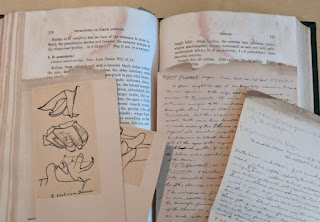The most painstaking part of compiling an accurate database for the Michigan Odonata Survey is verifying the correct identification of species that seem rare, in unlikely locations, or collected on unlikely dates. Sometimes these are just errors that occurred when the data was transcribed into the database, but a lot of them have been misidentifications. Access to the specimens in the University of Michigan Museum of Zoology (UMMZ) insect collection has been hampered by the pandemic, as well as the fact that the insect collection has been without a collections manager much of the last 3 years.
One significant finding was made in late 2019, when we became aware of a species that was not included in previous checklists or databases: Dusky Dancer, Argia translata. Two adult specimens were cataloged as being in the UMMZ collection: a female collected by Rodger Mitchell on 25 June 1957, and a male, also collected by Mitchell, from 7 July 1957, both at the University's E.S. George Reserve in Livingston County.
The collection records noted they were "determined" (identified) by Leonora Gloyd. Dolly Gloyd, as she was known, played a central role in the history of Michigan Odonata study. She was associated with the UMMZ for over 60 years -- we will have much more to say about her in the future, but for now you can read a bit about her career in this article. Since she did so much work on damselflies including the genus Argia, we weren't too concerned that the specimens were misidentified. Unfortunately, we could not confirm this, as the specimens were missing at UMMZ. This could be for a number of reasons, the two most likely being that they may have been loaned out and not returned, or they were "misfiled" and ended up in the wrong drawer. The sheer number of specimens at the UMMZ is staggering and it's astonishing how everything is relatively well-organized, especially considering the whole collection was moved from central campus to the present location miles away.
We were now faced with whether or not to include Argia translata on the Michigan checklist without being sure there was physical proof. We made it a mission to find this species. We did so on 10 September 2019, collecting a male on the Huron River at Bandemer Park, Ann Arbor, Washtenaw County. We saw three more just across and down the river at Argo Park canoe launch area, usually perching on a rock just out of net's reach. The following year was lost due to covid, but this year we found them again at Argo, on the same rock, and collected another voucher on 16 August 2021, confirming a population on this stretch of the Huron. A week later, we found them on the Saline River at Wilson Park in Monroe County.
Argia translata has the largest distribution of the 100+ species in this genus, ranging from southern Ontario through to Peru. It the US, it's most common in eastern states, and irregular in the west. Here is the rough estimate of the regional distribution from Odonata Central:
This species is fairly large, mostly blackish-purple, and found in a variety of rivers, streams, ponds, and impoundments, often perching just offshore. The markings can be variable thoughout its range, in particular the amount of pale patterning on s8-10 and some of the thoracic markings on the male. This page has some scans of males.
This is a male from Washtenaw County, and it's pattern and coloration seem typical of those we've found in southeast Michigan. Teneral female Powdered Dancers, Argia moesta, might be mistaken for A. translata and they frequently occur in the same habitats together. An important way to distinguish these species is to look at the forewing pseudostigma and see if there is a crossvein below it -- this is characteristic of A. moesta and is not present in A. translata, as shown below.
Argia translata is the 169th species on the Michigan checklist.








